Question Number 184478 by Shrinava last updated on 07/Jan/23
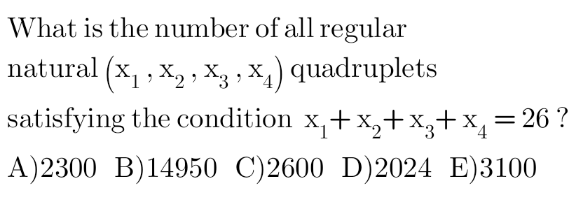
Answered by mr W last updated on 08/Jan/23
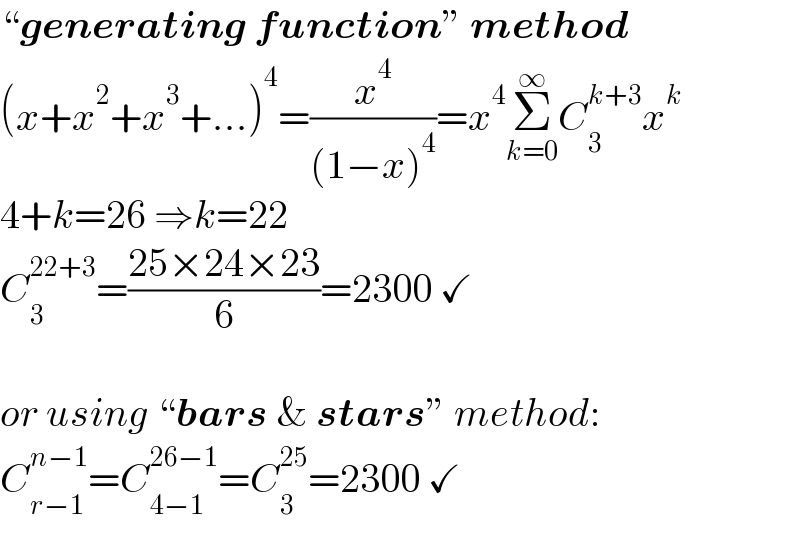
$$“\boldsymbol{{generating}}\:\boldsymbol{{function}}''\:\boldsymbol{{method}} \\ $$$$\left({x}+{x}^{\mathrm{2}} +{x}^{\mathrm{3}} +…\right)^{\mathrm{4}} =\frac{{x}^{\mathrm{4}} }{\left(\mathrm{1}−{x}\right)^{\mathrm{4}} }={x}^{\mathrm{4}} \underset{{k}=\mathrm{0}} {\overset{\infty} {\sum}}{C}_{\mathrm{3}} ^{{k}+\mathrm{3}} {x}^{{k}} \\ $$$$\mathrm{4}+{k}=\mathrm{26}\:\Rightarrow{k}=\mathrm{22} \\ $$$${C}_{\mathrm{3}} ^{\mathrm{22}+\mathrm{3}} =\frac{\mathrm{25}×\mathrm{24}×\mathrm{23}}{\mathrm{6}}=\mathrm{2300}\:\checkmark \\ $$$$ \\ $$$${or}\:{using}\:“\boldsymbol{{bars}}\:\&\:\boldsymbol{{stars}}''\:{method}: \\ $$$${C}_{{r}−\mathrm{1}} ^{{n}−\mathrm{1}} ={C}_{\mathrm{4}−\mathrm{1}} ^{\mathrm{26}−\mathrm{1}} ={C}_{\mathrm{3}} ^{\mathrm{25}} =\mathrm{2300}\:\checkmark \\ $$
Commented by Shrinava last updated on 07/Jan/23

$$\mathrm{thank}\:\mathrm{you}\:\mathrm{dear}\:\mathrm{professor} \\ $$$$\mathrm{r}\:=\:\mathrm{number}\:\mathrm{of}\:\mathrm{roots}?\:\mathrm{please} \\ $$
Commented by mr W last updated on 07/Jan/23

$${to}\:{put}\:{n}\:{balls}\:{into}\:{r}\:{boxes}\:{there}\:{are} \\ $$$${C}_{{r}−\mathrm{1}} ^{{n}−\mathrm{1}} \:{ways}. \\ $$
Commented by Shrinava last updated on 07/Jan/23
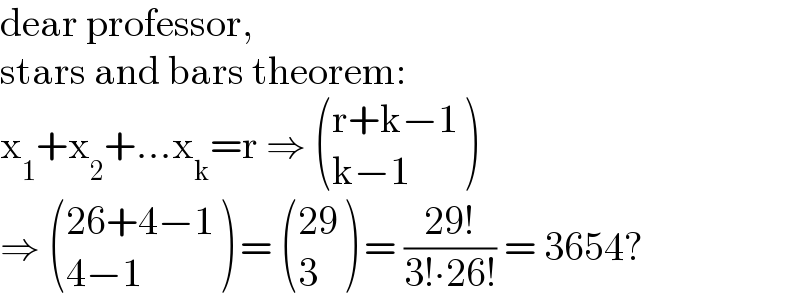
$$\mathrm{dear}\:\mathrm{professor}, \\ $$$$\mathrm{stars}\:\mathrm{and}\:\mathrm{bars}\:\mathrm{theorem}: \\ $$$$\mathrm{x}_{\mathrm{1}} +\mathrm{x}_{\mathrm{2}} +…\mathrm{x}_{\mathrm{k}} =\mathrm{r}\:\Rightarrow\:\begin{pmatrix}{\mathrm{r}+\mathrm{k}−\mathrm{1}}\\{\mathrm{k}−\mathrm{1}}\end{pmatrix} \\ $$$$\Rightarrow\:\begin{pmatrix}{\mathrm{26}+\mathrm{4}−\mathrm{1}}\\{\mathrm{4}−\mathrm{1}}\end{pmatrix}\:=\:\begin{pmatrix}{\mathrm{29}}\\{\mathrm{3}}\end{pmatrix}\:=\:\frac{\mathrm{29}!}{\mathrm{3}!\centerdot\mathrm{26}!}\:=\:\mathrm{3654}? \\ $$
Commented by mr W last updated on 08/Jan/23
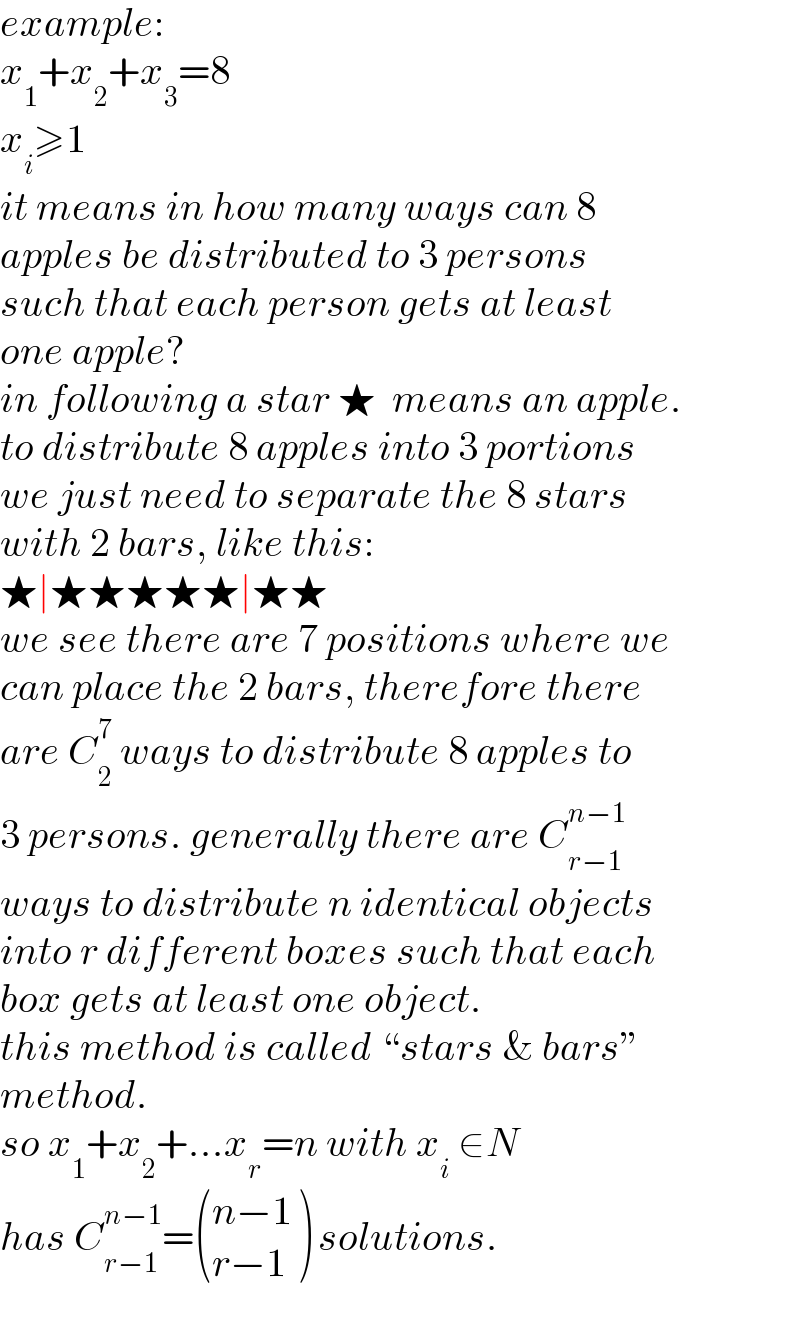
$${example}: \\ $$$${x}_{\mathrm{1}} +{x}_{\mathrm{2}} +{x}_{\mathrm{3}} =\mathrm{8} \\ $$$${x}_{{i}} \geqslant\mathrm{1} \\ $$$${it}\:{means}\:{in}\:{how}\:{many}\:{ways}\:{can}\:\mathrm{8} \\ $$$${apples}\:{be}\:{distributed}\:{to}\:\mathrm{3}\:{persons} \\ $$$${such}\:{that}\:{each}\:{person}\:{gets}\:{at}\:{least} \\ $$$${one}\:{apple}? \\ $$$${in}\:{following}\:{a}\:{star}\:\bigstar\:\:{means}\:{an}\:{apple}. \\ $$$${to}\:{distribute}\:\mathrm{8}\:{apples}\:{into}\:\mathrm{3}\:{portions} \\ $$$${we}\:{just}\:{need}\:{to}\:{separate}\:{the}\:\mathrm{8}\:{stars} \\ $$$${with}\:\mathrm{2}\:{bars},\:{like}\:{this}: \\ $$$$\bigstar\mid\bigstar\bigstar\bigstar\bigstar\bigstar\mid\bigstar\bigstar \\ $$$${we}\:{see}\:{there}\:{are}\:\mathrm{7}\:{positions}\:{where}\:{we} \\ $$$${can}\:{place}\:{the}\:\mathrm{2}\:{bars},\:{therefore}\:{there} \\ $$$${are}\:{C}_{\mathrm{2}} ^{\mathrm{7}} \:{ways}\:{to}\:{distribute}\:\mathrm{8}\:{apples}\:{to} \\ $$$$\mathrm{3}\:{persons}.\:{generally}\:{there}\:{are}\:{C}_{{r}−\mathrm{1}} ^{{n}−\mathrm{1}} \\ $$$${ways}\:{to}\:{distribute}\:{n}\:{identical}\:{objects} \\ $$$${into}\:{r}\:{different}\:{boxes}\:{such}\:{that}\:{each} \\ $$$${box}\:{gets}\:{at}\:{least}\:{one}\:{object}. \\ $$$${this}\:{method}\:{is}\:{called}\:“{stars}\:\&\:{bars}'' \\ $$$${method}. \\ $$$${so}\:{x}_{\mathrm{1}} +{x}_{\mathrm{2}} +…{x}_{{r}} ={n}\:{with}\:{x}_{{i}} \:\in{N} \\ $$$${has}\:{C}_{{r}−\mathrm{1}} ^{{n}−\mathrm{1}} =\begin{pmatrix}{{n}−\mathrm{1}}\\{{r}−\mathrm{1}}\end{pmatrix}\:{solutions}. \\ $$
Commented by mr W last updated on 08/Jan/23
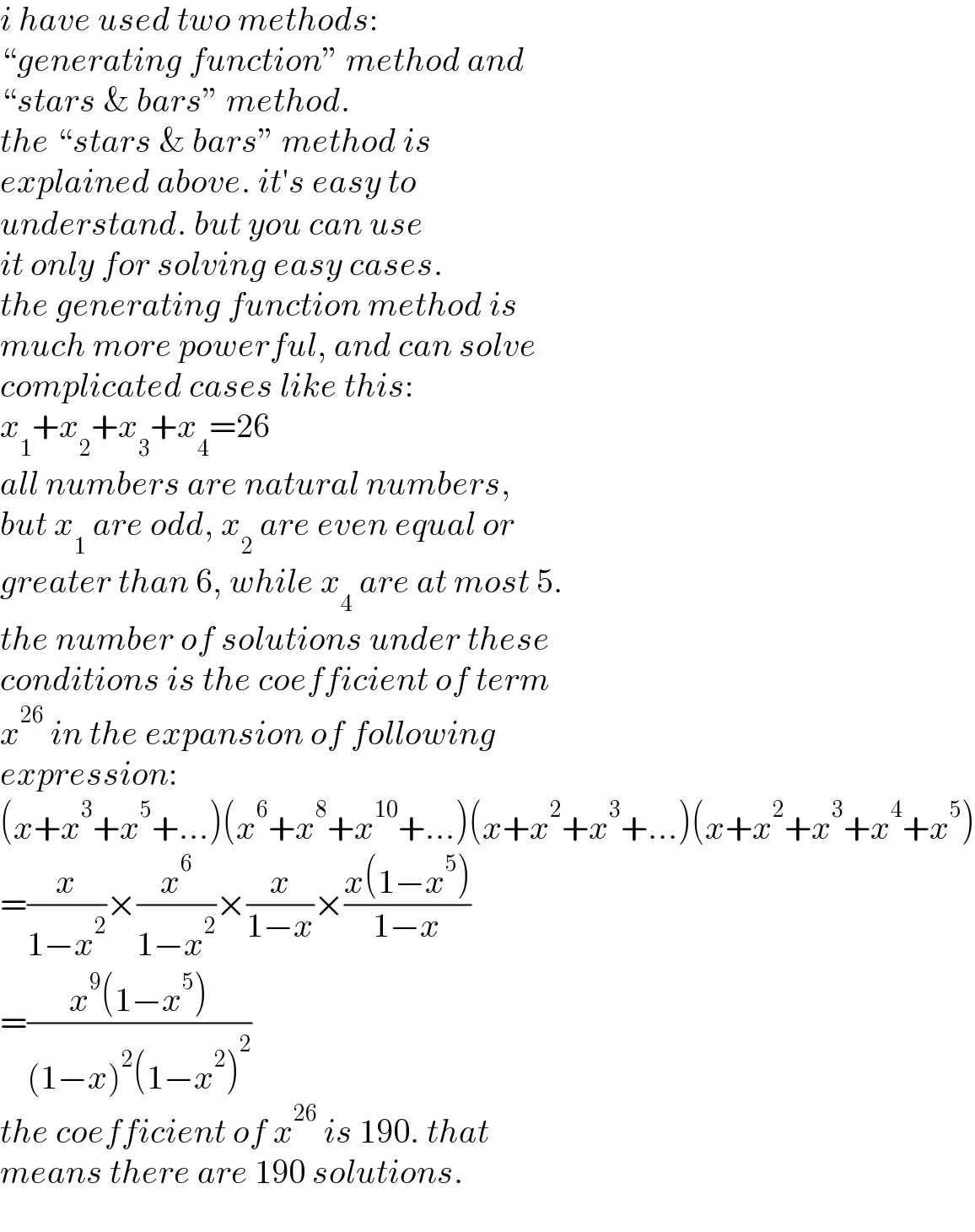
$${i}\:{have}\:{used}\:{two}\:{methods}: \\ $$$$“{generating}\:{function}''\:{method}\:{and} \\ $$$$“{stars}\:\&\:{bars}''\:{method}.\: \\ $$$${the}\:“{stars}\:\&\:{bars}''\:{method}\:{is}\: \\ $$$${explained}\:{above}.\:{it}'{s}\:{easy}\:{to}\: \\ $$$${understand}.\:{but}\:{you}\:{can}\:{use} \\ $$$${it}\:{only}\:{for}\:{solving}\:{easy}\:{cases}.\: \\ $$$${the}\:{generating}\:{function}\:{method}\:{is}\: \\ $$$${much}\:{more}\:{powerful},\:{and}\:{can}\:{solve}\: \\ $$$${complicated}\:{cases}\:{like}\:{this}: \\ $$$${x}_{\mathrm{1}} +{x}_{\mathrm{2}} +{x}_{\mathrm{3}} +{x}_{\mathrm{4}} =\mathrm{26} \\ $$$${all}\:{numbers}\:{are}\:{natural}\:{numbers}, \\ $$$${but}\:{x}_{\mathrm{1}} \:{are}\:{odd},\:{x}_{\mathrm{2}} \:{are}\:{even}\:{equal}\:{or} \\ $$$${greater}\:{than}\:\mathrm{6},\:{while}\:{x}_{\mathrm{4}} \:{are}\:{at}\:{most}\:\mathrm{5}. \\ $$$${the}\:{number}\:{of}\:{solutions}\:{under}\:{these} \\ $$$${conditions}\:{is}\:{the}\:{coefficient}\:{of}\:{term} \\ $$$${x}^{\mathrm{26}} \:{in}\:{the}\:{expansion}\:{of}\:{following} \\ $$$${expression}: \\ $$$$\left({x}+{x}^{\mathrm{3}} +{x}^{\mathrm{5}} +…\right)\left({x}^{\mathrm{6}} +{x}^{\mathrm{8}} +{x}^{\mathrm{10}} +…\right)\left({x}+{x}^{\mathrm{2}} +{x}^{\mathrm{3}} +…\right)\left({x}+{x}^{\mathrm{2}} +{x}^{\mathrm{3}} +{x}^{\mathrm{4}} +{x}^{\mathrm{5}} \right) \\ $$$$=\frac{{x}}{\mathrm{1}−{x}^{\mathrm{2}} }×\frac{{x}^{\mathrm{6}} }{\mathrm{1}−{x}^{\mathrm{2}} }×\frac{{x}}{\mathrm{1}−{x}}×\frac{{x}\left(\mathrm{1}−{x}^{\mathrm{5}} \right)}{\mathrm{1}−{x}} \\ $$$$=\frac{{x}^{\mathrm{9}} \left(\mathrm{1}−{x}^{\mathrm{5}} \right)}{\left(\mathrm{1}−{x}\right)^{\mathrm{2}} \left(\mathrm{1}−{x}^{\mathrm{2}} \right)^{\mathrm{2}} } \\ $$$${the}\:{coefficient}\:{of}\:{x}^{\mathrm{26}} \:{is}\:\mathrm{190}.\:{that} \\ $$$${means}\:{there}\:{are}\:\mathrm{190}\:{solutions}.\: \\ $$
Commented by Shrinava last updated on 08/Jan/23

$$\mathrm{cool}\:\mathrm{dear}\:\mathrm{professor}\:\mathrm{thank}\:\mathrm{you} \\ $$
